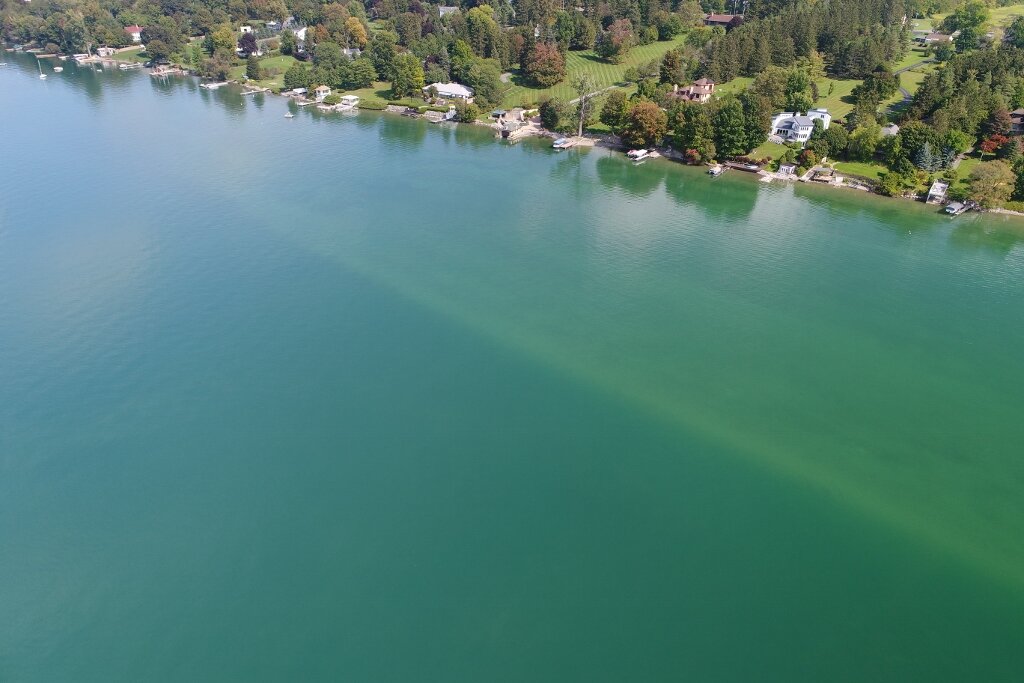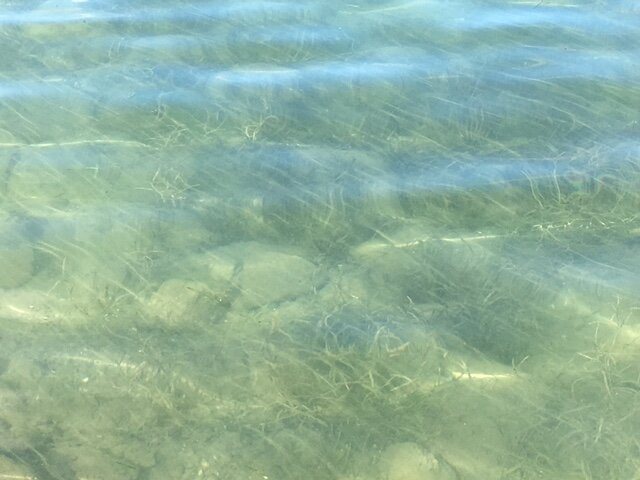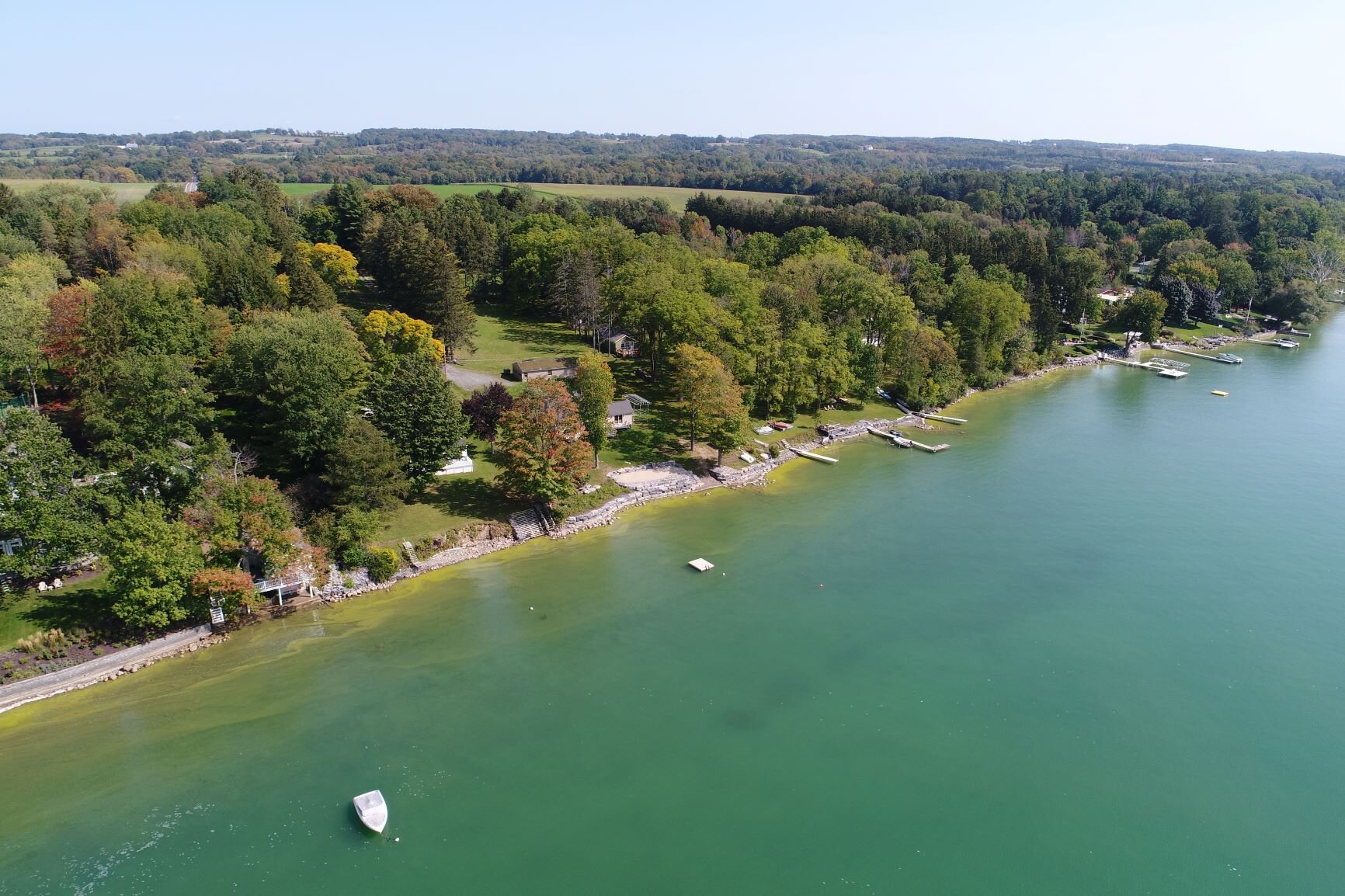Click Here to Report a Bloom.
Click Here to View Locations of Reported Blooms.
Click Here for the NYSDEC HABs Homepage.
A few facts about Harmful Algae Bloom (HAB) Reporting on Skaneateles Lake:
The report of possible small and large localized blooms in multiple locations are based on visual observations.
The City of Syracuse Water Department monitors the public drinking water for the presence of toxins associated with harmful algal blooms (microcystin) - this data can be found on our Microcystin Results page.
If conditions in the municipal drinking water supply warrant a public health advisory, one will be issued by the Onondaga County Health Department. However, please continue to observe recommended responses to suspected HABs from the NYSDOH and NYSDEC.
Plans to extend the depth of one of the drinking water intake lines will likely reduce the potential to draw cyanobacteria (blue-green algae) into the water intake line. It will also improve water quality, ensuring customers who rely on Skaneateles Lake for drinking water have continued access to high-quality water well into the future.
DEC definitions of small and large, localized blooms:
“Small, localized” bloom = HAB in a small area of the waterbody, limited from one to several neighboring properties.
“Large, localized” bloom = HAB near many properties, within an entire cove, along a large segment of the shoreline, or in a specific region of a waterbody.
“Open Water” bloom = HAB in the center of a lake, which may indicate that the HAB is widespread, and conditions may be worse along shorelines or within recreational areas.
“Widespread or Lakewide” bloom: HAB in an entire waterbody, a large portion of a lake, or most to all of the shoreline.
What is a Harmful Algal Bloom (HAB)?
Some types of algae can produce toxins that can be harmful to people and animals. Algal blooms that produce toxins are known as Harmful Algal Blooms (HABs). Environmental conditions that contribute to the formation of HABs in bodies of water include excess nutrients (phosphorus and nitrogen), abundant sunlight, calm water conditions, and warmer temperatures. Click here for FAQs about blue-green algae from the Onondaga County Health Department.
What does a Harmful Algal Bloom (HAB) look like?
Know It
Surface water that is discolored with a paint-like or filmy appearance or floating scum should always be avoided as they are potentially harmful. Images of these types of blooms as well as non-harmful blooms can be viewed on the NYS DEC’s HABs Photo Gallery. Weather influences where harmful algae blooms will occur. During extended periods of calm and sunny days, blooms can accumulate at the surface in any location. Wind and waves may cause them to form along shorelines or in protected areas. Shifts in wind direction can move a bloom from one location to another. Periods of cool rainy weather can often lead to the disappearance of a bloom.
(see images to the right for examples of past HABs on Skaneateles Lake)




Avoid It
People, pets, and livestock should avoid contact with water that is discolored or has floating scum on the surface. If contact does occur, rinse the exposed skin thoroughly with clean water. Always stay away from blooms in surface waters - avoid wading, swimming, fishing, boating, or eating fish caught in areas with blooms or in water bodies that are discolored or have scum or floating mats present.
Report It
If you think that a bloom may be harmful and is present on Skaneateles Lake, please report it to the New York State Department of Environmental Conservation (NYSDEC) using the NYSDEC Suspicious Algal Bloom Report Form. Email the DEC at HABsinfo@dec.ny.gov if you are not able to complete the form.
What should I do if I see a Harmful Algal Bloom on a body of water?
Symptoms such as vomiting, nausea, diarrhea, skin, eye or throat irritation, allergic reactions or breathing difficulties may occur after drinking water with elevated levels of toxins associated with harmful algal blooms. These symptoms are very similar to symptoms from other gastrointestinal illnesses or allergic reactions. Stop drinking the water and seek medical attention if you or a family member experience these symptoms.
Gastroenteritis which may include diarrhea, vomiting, and abdominal pain, and liver and kidney damage have been reported in humans following short-term exposure to toxins associated with harmful algal blooms in drinking water. However, more research is needed to fully understand the health effects.
Recreational exposures can occur while swimming, wading, fishing, or boating in areas with harmful algal blooms if this water is touched or swallowed, or when airborne droplets are inhaled. Exposure to harmful algal blooms can cause diarrhea, nausea, or vomiting; skin, eye, or throat irritation; and allergic reactions or breathing difficulties. Seek medical attention if you experience these symptoms after exposure to harmful algal blooms.
According to the New York State Department of Health, generally there have been infrequent reports of illnesses associated with recreational exposure to harmful algal blooms, and most of illnesses reported were minor. Since the symptoms from harmful algal bloom exposure are very similar to symptoms from other gastrointestinal illnesses or allergic reactions, we expect that bloom-related illnesses are under-reported.
What are the possible health effects from Harmful Algal Blooms?
What health effects may my pet experience if exposed to Harmful Algal Blooms?
Exposure to harmful algal blooms can be deadly for pets, especially if they drink water with harmful algal blooms or when they lick their fur after swimming in waters with harmful algal blooms.
Symptoms for animals include vomiting, diarrhea, loss of appetite, excessive salivation or drooling, stumbling, seizures, convulsions, paralysis, disorientation, inactivity, excessive tiredness, fast heart rate and difficulty breathing. Seek veterinary care if your pet experiences these symptoms after exposure to harmful algal blooms.
The City of Syracuse, the Onondaga County Health Department and the New York State Department of Health are monitoring the public drinking water for the presence of toxins associated with harmful algal blooms. Samples of the public drinking water are collected and sent to the New York State Department of Health laboratory on a regular basis during the harmful algal bloom season to determine if toxins are present.
The Onondaga County Health Department will notify the public when alternative water should be used for drinking, making infant formula, making ice, brushing teeth and preparing food.
The Onondaga County Health Department in consultation with the New York State Department of Health will issue necessary advisories for drinking water if levels exceed normal limits.
How is the public drinking water being monitored?
If a private well is a properly installed drilled well, it is unlikely to be impacted by Harmful Algal Blooms present in the lake. If the well is a shallow well installed along the shore of a lake experiencing a harmful algal bloom, toxins associated with the bloom may be present in the well water. In-home treatments such as boiling, disinfecting water with chlorine or ultraviolet (UV), and water filtration units do not remove the toxins associated with harmful algal blooms. There are treatment units on the market that have been shown to reduce microcystin levels in water, but it is not known if the microcystins would be reduced to a level considered safe. Since individual water supplies are not regulated or monitored, it is not known if there is a health risk to drinking the water from your private well.
If I live near a lake experiencing a HAB, is my private well water safe?
Never drink untreated surface water, whether or not harmful algal blooms are present. Even if the water is treated by in-home treatment units, DO NOT DRINK water drawn directly from the lake and DO NOT USE the water for making infant formula, making ice, brushing teeth, preparing food, and washing dishes when blooms are present. In-home treatments such as boiling, ultraviolet radiation (UV), and water filtration units do not remove the toxins associated with harmful algal blooms. There are treatment units on the market that have been shown to reduce microcystin levels in water, but it is not known if the microcystins would be reduced to a level considered safe. Since individual water supplies are not regulated or monitored, it is not known if there is a health risk to drinking the water from your private water supply.
The Onondaga County Health Department in consultation with the New York State Department of Health will advise those drawing water directly from Skaneateles Lake when testing shows undetectable levels of toxin in the Lake.
If I draw my water directly from the lake experiencing a bloom, is my water safe to drink, wash dishes, etc.?
Other Resources
NYS Department of Health: Understand the Risks of Piping Surface Water into Your Home
CCE Onondaga: Know it. Avoid it. Report it. Harmful Algal Blooms (HABs) - Important Contacts for Skaneateles Residents
CCE Onondaga: Water Quality: A Resident's Guide to Helping Prevent HABs
Advancing the Understanding of Cyano-HABs in New York State: The Cyano-HABs Advanced Monitoring Pilot (NYSDEC/USGS publication)
Bloom: The Toxic Threat to the Finger Lakes
“Bloom” explores the recent outbreaks of cyanobacteria, also known as toxic algae or harmful algal blooms, across the eleven Finger Lakes. These blooms threaten drinking water, as well as a multi-billion-dollar tourism economy across Central New York. While research into this growing problem continues, “Bloom” goes beneath the waves to bring to the surface potential environmental culprits that are bringing disruption to those who call the Finger Lakes home.

